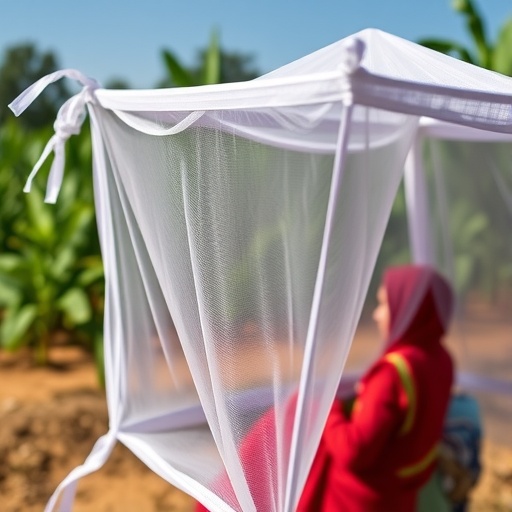In a groundbreaking advancement in the fight against malaria, researchers at Harvard T.H. Chan School of Public Health have identified a potent combination of antimalarial compounds that can be incorporated into bed nets to effectively block malaria parasite transmission in mosquitoes. This innovative approach meticulously targets the malaria-causing parasite without harming the mosquito vector, thereby circumventing the escalating challenge of insecticide resistance that has compromised current mosquito control strategies. The study, set to publish in the prestigious journal Nature, represents a significant paradigm shift in malaria prevention tactics designed to enhance global health outcomes.
For decades, malaria control has heavily relied on insecticide-treated bed nets, which function primarily by killing mosquitoes that come into contact with them. However, the alarming rise of insecticide resistance among Anopheles mosquito populations—the main vectors responsible for Plasmodium parasite transmission—has rendered these bed nets progressively less effective. This impasse has generated an urgent need for alternative strategies that disrupt transmission without exerting selective pressure on mosquito populations. The newly uncovered chemical combination promises to fulfill this need by targeting the parasite’s biology rather than killing the mosquito itself.
The research team embarked on a pioneering large-scale screen involving 81 antiparasitic compounds to determine their efficacy against Plasmodium falciparum—the deadliest malaria parasite responsible for over 90% of global malaria cases. Uniquely, the compounds were applied directly onto Anopheles gambiae mosquitoes to assess whether they could impair parasite development within the mosquito vector. This in vivo screening method is unprecedented in its scope and methodology, providing direct insights into the interaction between antimalarial agents and parasite development stages within the mosquito host.
Out of the extensive panel scrutinized, 22 compounds demonstrated significant impairment of parasite development. From this subset, researchers isolated two compounds exhibiting remarkable potency. These molecules exert their parasiticidal effect by inhibiting distinct enzymatic sites within the parasite’s mitochondrial electron transport chain—a critical metabolic pathway responsible for energy production. By targeting multiple sites, the combination not only amplifies the antiparasitic effect but also reduces the likelihood of resistance development in the parasite population.
Crucially, the compounds’ mechanism of action does not involve killing the mosquito, thereby eliminating the evolutionary pressure that typically fosters insecticide resistance. By preserving mosquito survival, this approach aligns vector control with ecological balance and sustainability principles. Lead author Alexandra Probst, a doctoral candidate involved in the research, highlights the relevance of integrating cost-effective chemistry; collaborators at Oregon Health and Science University successfully synthesized these compounds inexpensively, setting the stage for scalable implementation without imposing significant financial burdens.
Flaminia Catteruccia, a senior investigator and co-corresponding author, underscores the transformative potential of this discovery within malaria control. She emphasizes how addressing the parasite within the mosquito vector rather than targeting the mosquito itself represents a novel and promising direction—one that could revitalize malaria prevention amid stagnating progress in recent years. Given malaria’s staggering impact—263 million reported cases and nearly 600,000 deaths in 2023 alone—such innovations are critical to reversing the disease’s global toll.
The methodology employed in this research illuminates unexplored druggable targets during the mosquito-stage of the parasite’s life cycle, marking a departure from traditional antimalarials primarily focused on the human blood stage. By expanding the scope of antimalarial intervention to vector stages, the study positions itself at the forefront of vector-borne disease management research. This multidimensional targeting could pave the way for integrated approaches that combine human and vector treatment strategies for higher efficacy.
Furthermore, the study’s success rests heavily on interdisciplinary collaboration. Contributions spanned molecular parasitology, chemical synthesis, vector biology, and public health, highlighting the necessity of cross-sector partnerships in addressing complex infectious disease challenges. Funding support from the National Institutes of Health, Open Philanthropy, and several foundations underscores the high priority accorded to such efforts within global health agendas.
Looking forward, the translation of these findings into commercial antimalarial bed nets will require concerted development and regulatory efforts. Nonetheless, by circumventing the pitfalls of insecticide resistance and maintaining cost competitiveness, this advancement holds the promise of ushering in a new generation of vector control tools with the potential to substantially reduce malaria transmission worldwide. Given the sustained activity of the compounds and the ability to preempt infection in mosquitoes, deployment could radically shift the epidemiological landscape—saving lives and improving health equity in malaria-endemic regions.
In an era where malaria control has stagnated due to resistance challenges and the limits of current technologies, this research offers a beacon of hope. By simultaneously leveraging advances in chemistry, vector biology, and parasitology, the Harvard-led team has charted a course toward innovative, sustainable, and highly effective malaria prevention. This strategy not only strengthens the fight against one of humanity’s oldest scourges but exemplifies how cutting-edge science can yield practical, life-saving solutions.
Subject of Research: Animals
Article Title: In vivo screen of Plasmodium targets for mosquito-based malaria control
News Publication Date: May 21, 2025
Web References:
http://dx.doi.org/10.1038/s41586-025-09039-2
References:
Probst, A. S., Paton, D. G., Appetecchia, F., Bopp, S., Adams, K. L., Rinvee, T. A., et al. (2025). In vivo screen of Plasmodium targets for mosquito-based malaria control. Nature. doi:10.1038/s41586-025-09039-2
Keywords: Malaria, Plasmodium infections, Mosquitos, Drug resistance, Insecticide resistance, Insecticides
Tags: alternative mosquito control methodsantimalarial compounds in bed netschemical combinations for malariaeffective bed net technologiesenhancing global health outcomesHarvard T.H. Chan School of Public Health researchinsecticide resistance in Anopheles mosquitoesmalaria control innovationsmosquito parasite transmissionnew malaria prevention strategiesPlasmodium transmission disruptiontargeting malaria-causing parasites





